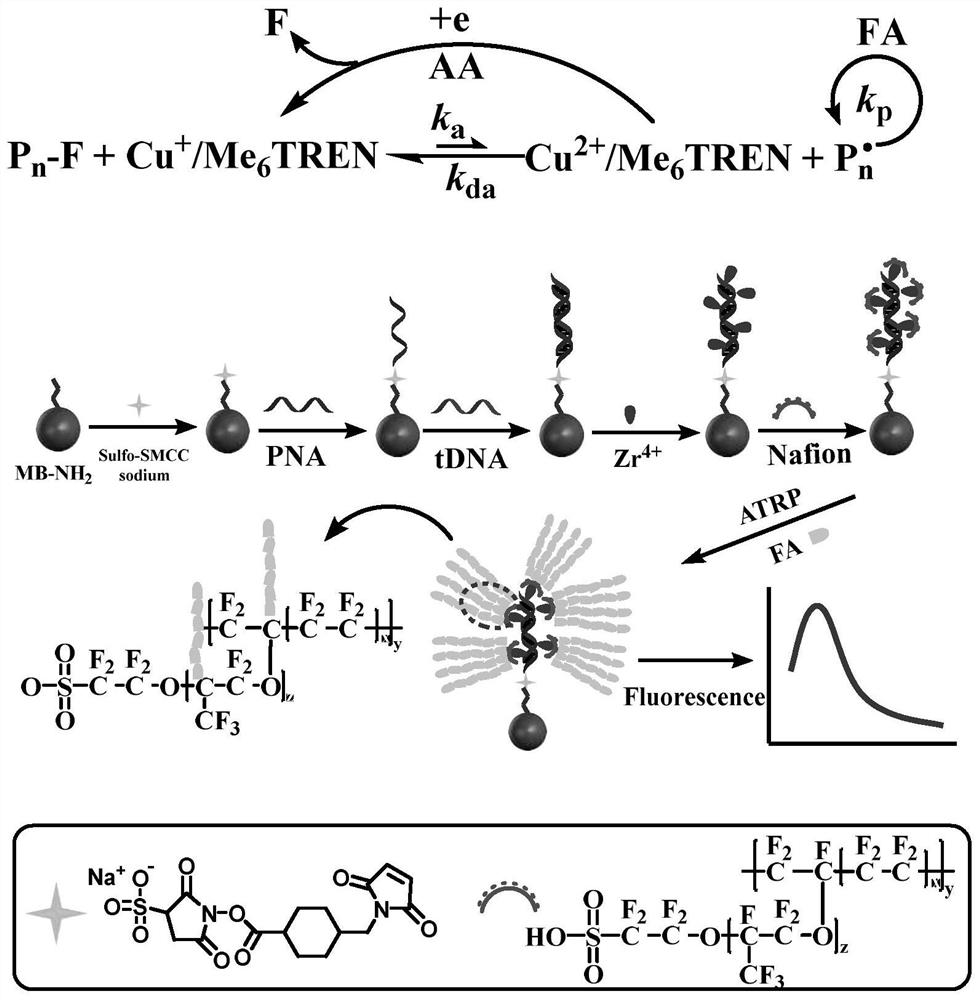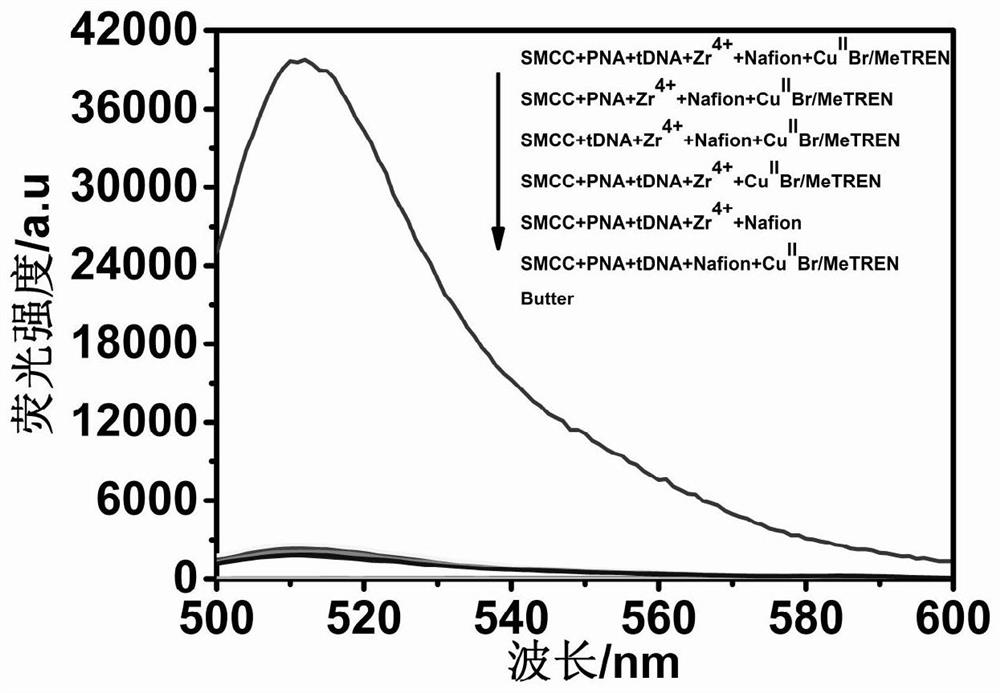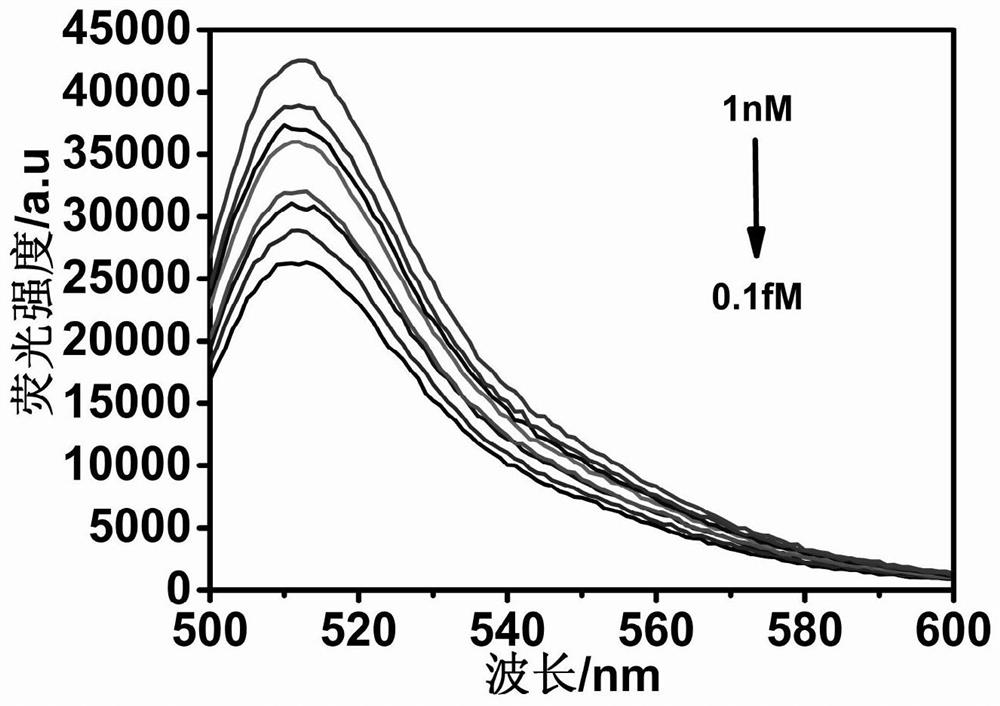A kit for early diagnosis of lung cancer based on signal amplification of nafion-induced atom transfer radical polymerization
A technology of polymerization reaction and signal amplification, applied in the field of biological analysis, to achieve the effect of increasing polymerization rate and stability, improving stability and reproducibility, and improving polymerization efficiency
- Summary
- Abstract
- Description
- Claims
- Application Information
AI Technical Summary
Problems solved by technology
Method used
Image
Examples
Embodiment 1
[0054] Example 1. Construction of diagnostic kit
[0055] The kit includes amino Fe 3 O 4 Magnetic bead solution (10 mg / mL), Sulfo-SMCC solution (100 μM), PNA solution (0.5 μM), ZrClO 2 solution (5mM), Nafion solution ( 117 solution), Fluorescein O-acrylate (FA) solution (10 mM), AA solution (2 mM), Cu II Br / Me 6 TREN solution (10 mM), PBS buffer, DMF (N,N-dimethylformamide).
[0056] The preparation method of PBS buffer is: weigh 5.8g Na 2 HPO 4 .12H 2 O, 0.592g NaH 2 PO 4 .2H 2 O, 2.34g NaCl and 200μL ultrapure water were mixed to obtain; the concentration was 0.1M, and the pH was 7.4.
[0057] The preparation method of the ascorbic acid (AA) solution is as follows: AA is mixed with an ethanol solution with a volume fraction of 70% to prepare an AA solution with a concentration of 2 mM, which is stored at 4° C. for later use.
[0058] The preparation method of the fluorescein FA solution is as follows: FA and DMF are mixed to prepare a fluorescein FA solution wi...
Embodiment 2
[0060] Embodiment 2, the detection method of test kit
[0061] (1) Treatment and modification of amino magnetic beads:
[0062] ①Measure a certain amount of amino Fe 3 O 4 Magnetic bead solution (10mg / mL), magnetic separation, remove supernatant, wash with PBS buffer, magnetic separation, remove supernatant, add PBS buffer to resuspend and restore to the measured volume of magnetic bead solution;
[0063] ②Measure 20μL of magnetic bead resuspension, add 20μL of Sulfo-SMCC solution and 160μL of PBS buffer, and after mixing, react in the dark for 2h under the condition of constant temperature shaker at 37°C and 200r / s, so that one end of the cross-linking agent SMCC is mixed with Amino magnetic beads are bound by amide bonds;
[0064] 3. Magnetically separate the mixture obtained in step (1)-2, remove the supernatant, wash with PBS buffer, magnetically separate, and remove the supernatant;
[0065] ④Add 195μL of PBS buffer and 5μL of PNA solution, mix well, react overnight i...
Embodiment 3
[0077] Example 3. Feasibility verification
[0078] First, the fluorescence intensity of aminomagnetic beads with different modification states was detected by using a fluorescence spectrometer. like figure 2 As shown, no fluorescence intensity was detected with the addition of only PBS buffer (0.1 M, pH 7.4). Instead, add SMCC / PNA / tDNA / Zr 4+ / Nafion / Cu II Br / Me 6 Obvious fluorescence emission peaks could still be observed after multiple washings after TREN, which is because a large amount of FA was introduced to the magnetic beads through ATRP, which produced a great fluorescence signal. At the same time, without adding Zr 4+ , Cu II Br / Me 6 Under the conditions of TREN, Nafion, PNA, and tDNA, only relatively weak fluorescent signals were detected, which indicated that the experiment had high sensitivity. Through comparative experiments, it is fully proved that the fluorescence signal amplification strategy based on ATRP polymerization is feasible for the detection o...
PUM
| Property | Measurement | Unit |
|---|---|---|
| wavelength | aaaaa | aaaaa |
| width | aaaaa | aaaaa |
Abstract
Description
Claims
Application Information
 Login to View More
Login to View More - R&D
- Intellectual Property
- Life Sciences
- Materials
- Tech Scout
- Unparalleled Data Quality
- Higher Quality Content
- 60% Fewer Hallucinations
Browse by: Latest US Patents, China's latest patents, Technical Efficacy Thesaurus, Application Domain, Technology Topic, Popular Technical Reports.
© 2025 PatSnap. All rights reserved.Legal|Privacy policy|Modern Slavery Act Transparency Statement|Sitemap|About US| Contact US: help@patsnap.com



